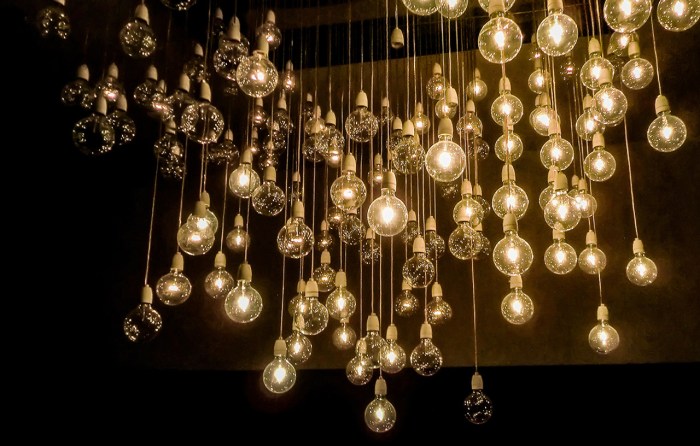Decorative light bulbs are more than just functional; they’re design elements that can transform a space. From the classic Edison bulb’s warm glow to the sleek modernity of a frosted globe, these versatile lighting options offer endless possibilities for enhancing your home or commercial environment. This exploration delves into the diverse types, applications, aesthetic considerations, and technical specifications of decorative light bulbs, empowering you to make informed choices that perfectly complement your style and needs.
We’ll cover a wide range of topics, including the various shapes, materials, and finishes available, along with guidance on selecting the right bulbs for different room types and design aesthetics. We’ll also examine the technical aspects, such as wattage, base types, and energy efficiency, ensuring you understand the practical considerations alongside the creative potential.
Illustrative Examples: Decorative Light Bulbs

Decorative light bulbs offer a vast array of design possibilities, transforming a simple lighting fixture into a statement piece. The following examples illustrate the diverse shapes, materials, finishes, and applications of these versatile elements, highlighting their impact on interior design.
Three Decorative Light Bulb Designs
The following descriptions detail three distinct decorative light bulb designs, emphasizing their unique characteristics and intended applications. These examples showcase the breadth of design options available in the market.
- Design 1: Edison-Style Filament Bulb: This classic design features a clear glass globe (approximately 120mm in height and 60mm in diameter), showcasing a visible, exposed filament. The filament is often made of tungsten, offering a warm, amber glow. The bulb is typically finished with a brushed brass or antique copper base, lending a vintage aesthetic. This type of bulb is ideal for creating a nostalgic, industrial-chic ambiance in spaces like lofts, cafes, or dining rooms.
Color variations may include a slightly tinted amber or a clear glass to emphasize the filament’s glow.
- Design 2: Globe-Shaped, Opal Glass Bulb: This design utilizes an opal glass globe (approximately 100mm in diameter) that diffuses light softly and evenly. The opal glass creates a gentle, ambient glow without harsh shadows. The bulb’s finish is a smooth, frosted white, providing a clean, contemporary look. Its soft, diffused light makes it suitable for bedrooms, living rooms, or any space requiring a calming and relaxed atmosphere.
Color variations are limited, but some manufacturers offer subtle tints of cream or light gray.
- Design 3: Geometric, Smoked Glass Bulb: This contemporary design features a geometric shape, such as a cube or a hexagonal prism (approximately 80mm x 80mm x 80mm for a cube), crafted from smoked gray glass. The smoked glass subtly filters the light, creating a moody, sophisticated ambiance. The bulb’s metallic base might be black or dark bronze, complementing the smoked glass. This style is perfect for modern or minimalist interiors, adding a touch of drama and visual interest.
Color variations could include different shades of gray or even a dark amber smoked glass.
Decorative Light Bulbs in an Interior Design Setting
Imagine a modern living room with exposed brick walls and minimalist furniture. Several Edison-style filament bulbs hang over a low-slung sofa, their warm, amber glow casting a welcoming light. These are complemented by smaller, globe-shaped opal glass bulbs integrated into recessed lighting, providing a soft, ambient illumination that accentuates the room’s texture. The contrast between the warm, focused light of the Edison bulbs and the soft, diffused light of the opal bulbs creates a dynamic and inviting atmosphere.
The overall effect is a sophisticated blend of vintage and contemporary aesthetics, showcasing the versatility of decorative light bulbs in creating distinct ambiances.
Visual Texture and Light Diffusion, Decorative Light Bulbs
Different materials used in decorative light bulbs significantly impact their visual texture and light diffusion properties. For instance, clear glass bulbs offer a clean, transparent look, allowing the filament to be fully visible and creating a more focused light beam. Opal glass, on the other hand, diffuses light more evenly, creating a softer, less intense glow. Smoked glass, with its inherent opacity, filters the light, reducing its intensity and adding a moody, dramatic effect.
The texture of the glass itself can also vary, from smooth and polished to textured and etched, further influencing the light’s diffusion and the bulb’s overall aesthetic. Metallic finishes, such as brass or copper, add a reflective element, enhancing the light’s warmth and creating subtle highlights.
Ultimately, the choice of decorative light bulbs is a personal journey reflecting your unique style and preferences. By understanding the diverse options available and the impact they can have on ambiance and aesthetics, you can confidently illuminate your spaces with personality and flair. Whether you’re aiming for a rustic charm, modern minimalism, or something entirely unique, the right decorative light bulb can elevate your design to the next level.
Let your creativity shine!